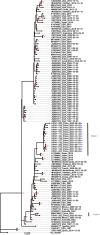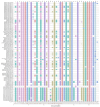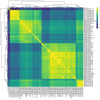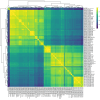Epidemiology and genetic characterization of human parainfluenza virus-1 infection in pediatric patients from Hangzhou China, 2021-2022
- PMID: 39223668
- PMCID: PMC11367859
- DOI: 10.1186/s12985-024-02479-8
Epidemiology and genetic characterization of human parainfluenza virus-1 infection in pediatric patients from Hangzhou China, 2021-2022
Abstract
Background: Human parainfluenza virus-1 (HPIV-1) is a notable pathogen instigating acute respiratory tract infections in children. The article is to elucidate the epidemiological and genetic characteristics of HPIV-1 circulating in Hangzhou during the period of 2021-2022.
Methods: A cohort of 2360 nasopharyngeal swabs were amassed and subsequently examined via RT-PCR, with HPIV-1 positive samples undergoing P gene sequencing.
Results: The highest HPIV-1 infection rates were found in children aged between 3 and 6 years. A pronounced positive rate persisted through the latter half of 2021, with a notable decline observed in the initial half of 2022. All HPIV-1 strains could be clustered into 2 groups: Cluster 1, with strains similar to those found in Japan (LC764865, LC764864), and Cluster 2, with strains similar to the Beijing strain (MW575643).
Conclusion: In conclusion, our study contributes to the comprehensive data on the epidemiological and genetic characteristics of HPIV-1 in pediatric patients from Hangzhou, post the COVID-19 peak.
Keywords: Children; Epidemiology; Genetic; Human parainfluenza virus-1; Infectious.
© 2024. The Author(s).
Conflict of interest statement
The authors declare no competing interests.
Figures






Similar articles
-
Molecular Epidemiology of Human Parainfluenza Virus Type 3 in Children With Acute Respiratory Tract Infection in Hangzhou.Influenza Other Respir Viruses. 2024 Jul;18(7):e13351. doi: 10.1111/irv.13351. Influenza Other Respir Viruses. 2024. PMID: 38965872 Free PMC article.
-
Human parainfluenza virus-associated respiratory tract infection among children and genetic analysis of HPIV-3 strains in Beijing, China.PLoS One. 2012;7(8):e43893. doi: 10.1371/journal.pone.0043893. Epub 2012 Aug 28. PLoS One. 2012. PMID: 22937119 Free PMC article.
-
Human parainfluenza virus types 1-4 in hospitalized children with acute lower respiratory infections in China.J Med Virol. 2016 Dec;88(12):2085-2091. doi: 10.1002/jmv.24580. Epub 2016 May 30. J Med Virol. 2016. PMID: 27197630 Free PMC article.
-
Genetic characteristics of human parainfluenza viruses 1-4 associated with acute lower respiratory tract infection in Chinese children, during 2015-2021.Microbiol Spectr. 2024 Oct 3;12(10):e0343223. doi: 10.1128/spectrum.03432-23. Epub 2024 Sep 12. Microbiol Spectr. 2024. PMID: 39264196 Free PMC article.
-
Parainfluenza Virus Infection.Semin Respir Crit Care Med. 2016 Aug;37(4):538-54. doi: 10.1055/s-0036-1584798. Epub 2016 Aug 3. Semin Respir Crit Care Med. 2016. PMID: 27486735 Free PMC article. Review.
References
-
- Karron RA, Collins PL. Parainfluenza viruses. In: Knipe DM, and Howley PM, editors. Fields virology, 6th Edn. Philadelphia: Lippincott-Williams & Wilkins; 2013. p. 996–1023.
Publication types
MeSH terms
LinkOut - more resources
Full Text Sources

